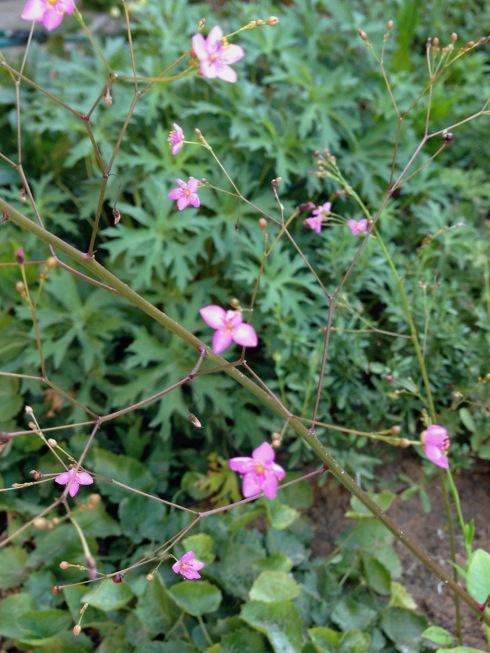The only blue that gardeners in my HOT, HOT, HOT valley really want to see right now is the blue water of a cool swimming pool! With our temps for the week forecasted to peak at 111 degrees on Friday it is hard to even think about getting out in the garden to see what’s happening. Late July to early August is the perfect time to cut back by half many perennials which have been blooming since early spring. This will force them to rest a bit, not expending too much energy in supporting blooms. This brief rest during our hottest time usually results in some new growth pushed in September and possibly additional blooming periods taking them up to the winter cold. The complicating factor for me is that I have to get out to do that cut back starting around 6 am and only have a few hours until only crazy people are working in the yard!
Many plants have stopped blooming due to the excessive heat but I do have a couple of cool blues in bloom to share with you.
Platycondon grandiflorus ‘Sentimental Blue’ is a dwarf selection of the old fashioned favorite balloon flower found in our grandmothers’ gardens.
This cultivar has a very compact upright growth habit reaching from 6″-12″ tall and 12″ wide. In the left photo at upper right you can see one of the platycondon’s characteristic hot air balloon shaped white buds. These whimsical flower buds open to a star shaped blue violet flower highlighted by darker blue veins. Anybody notice a resemblance to another plant I have featured in previous posts? Platycondon grandiflorus is in the same plant family, Campanulaceae, as the campanula or bellflower. This is a great front of the border or bed perennial and reliably comes back for me every year. Plants grown from seed will take a couple of years to get well established. Although they perform better with weekly water, they have a deep fleshy root that, once established, seems to keep them going during lean watering periods. My plants came from six packs planted 4 or 5 years ago and they flower freely for 6 months of the year.
Tradescantia ‘Sweet Kate’ is an easy to grow perennial whose deep blue flowers are an eye catching contrast to its yellow green grasslike foliage.
The common name for this plant is spiderwort. According to the Kemper Center for Home Gardening when the stems of spiderworts are cut, a viscous stem secretion is released which becomes threadlike and silky upon hardening (like a spider’s web.) You can also see the resemblance to one of its cousins, the wandering jew, that we all grew in hanging baskets in the 70’s! There are many garden varieties of spiderwort with flower color varying from white to blue to pink and near red but this one is unique in its foliage color. Individual flowers last only a day but the buds come in large clusters and once they get started they are rarely out of bloom through the summer months. A single plant will form a tidy clump about 18″ X 18″. Although many tradescantia varieties are invasive self sowers and rampant spreaders ‘Sweet Kate’ is quite well behaved. Give it moist soil and a partial sun only location for best success.
Stay cool and take time to smell the flowers this summer!








